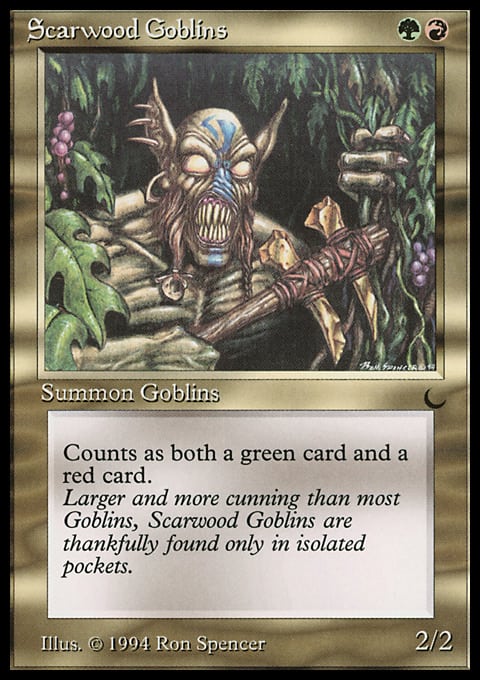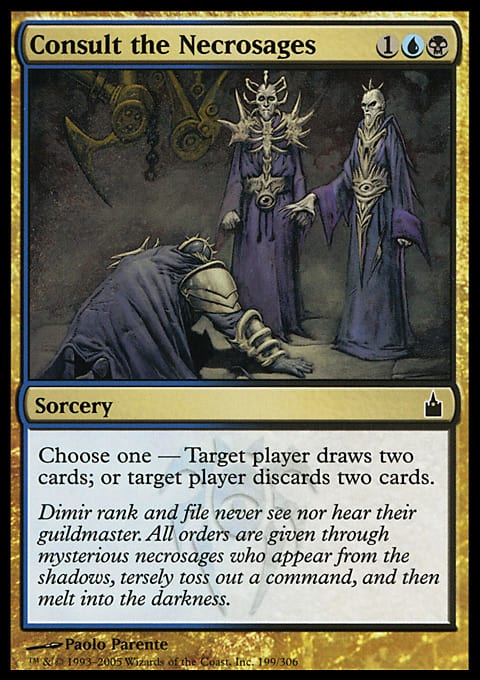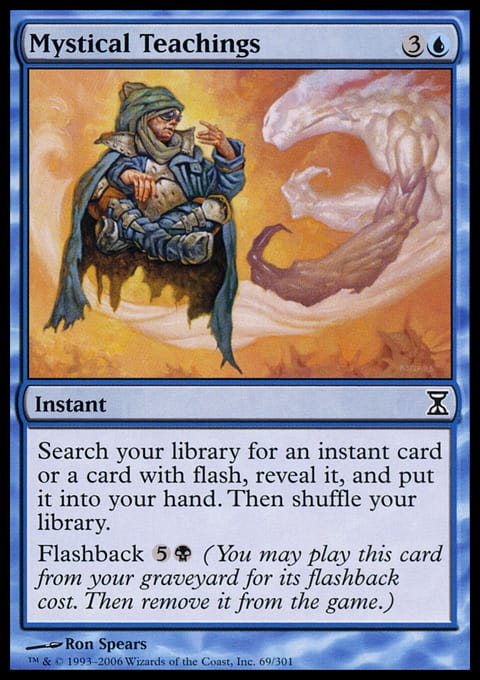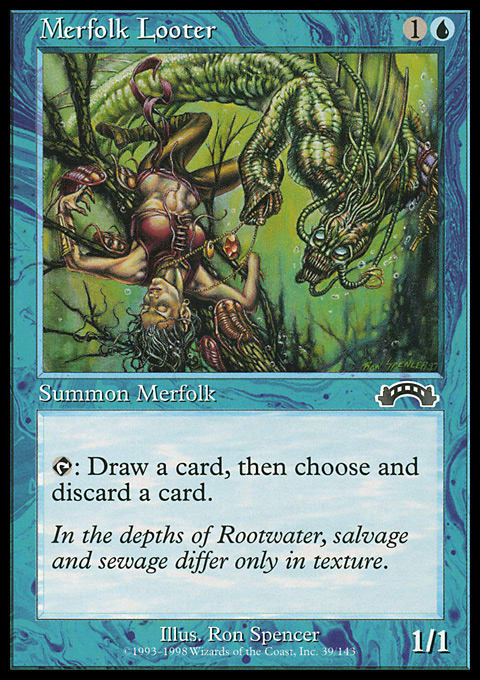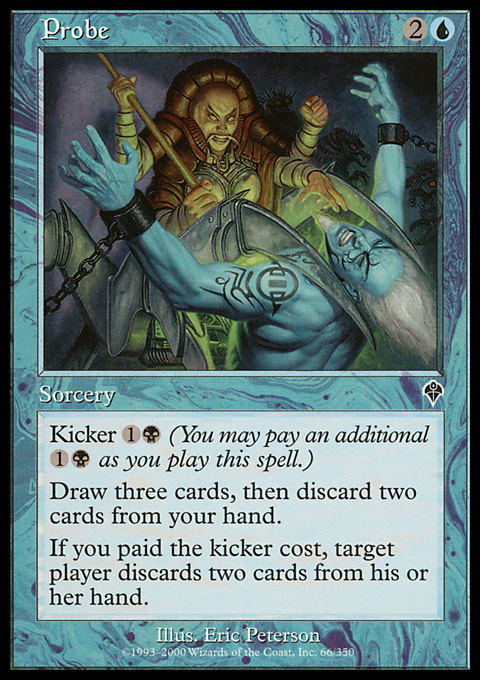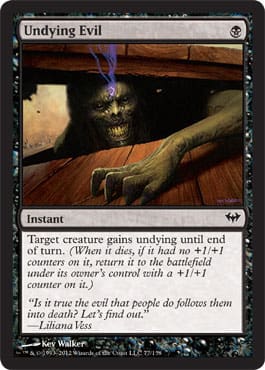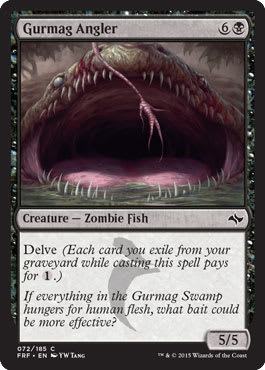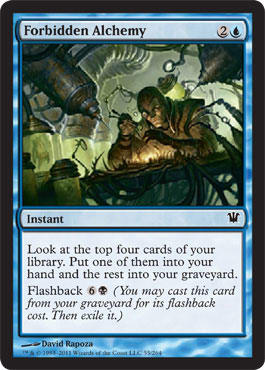There is an allure to gold cards. I can’t speak for everyone, but I remember I was hooked the first time I saw Scarwood Goblins. The idea of getting something that was two colors at once was so cool to my preteen self. I was not sure how a two color card worked, but that goblin sank its teeth into me and has never really let go.
Pauper has a somewhat turbulent history with multicolored cards and decks. Formats are defined in part by the mana available, and while Pauper has access to a wide array of lands they all pale in comparison to basics. The best fair decks in the format — Delver and Stompy — rely on the rock solid mana base of Islands and Forests. When Mono-Black Control was on top, it was built on foundation of Swamps. There is a real cost associated with running any of the dual lands in Pauper — they all enter the battlefield tapped. Pauper is not a format where one can easily take off time to develop a mana base.
Yet there is a payoff. Gold cards can be more powerful than other spells at a similar converted mana cost. Compare Castigate to Distress; these cards have a parallel function in the game but the upside exists on Castigate in part because it costs two colors. There are many powerful multicolored cards available in Pauper but relatively few have found steady homes in top flight decks. Cards like Blightning and Terminate have seen constructed play in other formats but have largely languished in Pauper. One color combination has managed to carve out a niche in Pauper and it is due in part to the strength of its options but also where they fall on the mana curve.
Blue and Black — known as Dimir — has had decks contend in sanctioned Pauper since the very beginning of the format. Being the color combination that has historically been associated with card advantage pushes many of the options up on the mana curve. In turn it is easier for Dimir decks to run these cards as they are easier to cast. For example let’s look at Consult the Necrosages. While this card is a fine play on turn three it is potentially better later in the game as it can strip the final few cards from an adversary or reload a hand with mana left over to cast something. Compare this to a personal favorite of mine — Putrid Leech. Leech is at its best on turn two and experiences diminishing returns the longer the game goes. It quickly gets outclassed in battle and depending on the matchup its ability may be useless. Dimir cards may be slower but Blue and Black are perfectly set up take full advantage of their speed. As such playing Dismal Backwater and Dimir Aqueduct is less a liability and more an active part of a game plan.
So where did Dimir begin? Well, it all started with one of the best cards in Pauper.
Dimir Teachings ? Pauper| StiLLiRise, Finalist Pauper Premier Event, February 2009
- Creatures (4)
- 4 Errant Ephemeron
- Spells (33)
- 1 Condescend
- 1 Echoing Decay
- 1 Ghastly Demise
- 1 Muddle the Mixture
- 1 Prohibit
- 1 Repulse
- 2 Exclude
- 2 Remove Soul
- 2 Terror
- 4 Counterspell
- 4 Mystical Teachings
- 4 Rune Snag
- 4 Think Twice
- 2 Faerie Trickery
- 3 Prismatic Lens
- Lands (23)
- 18 Snow-Covered Island
- 5 Snow-Covered Swamp
- Sideboard (15)
- 1 Annul
- 1 Circle of Protection Black
- 2 Circle of Protection Red
- 2 Deep Analysis
- 1 Echoing Decay
- 1 Echoing Truth
- 4 Hydroblast
- 1 Remove Soul
- 2 Terror
The first instance of a Mystical Teachings based control deck in sanctioned Pauper came during the first Premier Event. Finishing second the deck operates very similarly to the builds of today. The goal is to simply stop every threat and then protect your own win condition. In these days Errant Ephemeron was the finisher of choice. The ability to be Suspended in the midgame while leaving up counters was hugely important and the Time Spiral standout did a great job of tussling with Spire Golem. Prismatic Lens here allowed the deck to jump ahead in mana development while also enabling sideboard copies of Circles of Protection.
Lacking from this early build was a true card quantity spell. Think Twice is good for two cards but there is not Deep Analysis or Compulsive Research to load up on cards. Similarly the mana base is comprised only of Basic Lands. Dimir Aqueduct and Terramorphic Expanse were both available but StiLLiRise opted to go with a purely untapped suite. Later versions of early Teachings would incorporate a few copies of the common fetchland and a Mysteries of the Deep as a way to refill a hand.
That very first Top 8 had two other Dimir decks. Sitting in third place was something very different.
Madness ? Pauper| Pedro_Alves, Top 4 Pauper Premier Event, February 2009
- Creatures (18)
- 2 Grave Scrabbler
- 4 Gathan Raiders
- 4 Looter il-Kor
- 4 Merfolk Looter
- 4 Mulldrifter
- Spells (20)
- 4 Agony Warp
- 4 Dark Withering
- 4 Ichor Slick
- 4 Ostracize
- 4 Psychotic Episode
- Lands (22)
- 7 Island
- 7 Swamp
- 4 Dimir Aqueduct
- 4 Terramorphic Expanse
- Sideboard (15)
- 4 Annul
- 3 Echoing Decay
- 4 Hydroblast
- 4 Negate
Pedro_Alves built an aggressive Madness deck and made it all the way to the semifinals before being turned aside. Leading on Terramorphic Expanse and Ostracize this deck is very different from anything currently played in Pauper. Madness started on turn two with either a Merfolk Looter or a Looter il-Kor and needed those cards to get its engines revved. Once it started, however, it was hard to stop. Drawing extra cards every turn and turning the discards into powerful spells could simply overwhelm many of the less prepared decks of the day. Dimir Aqueduct made hard-casting Mulldrifter attainable and also gave the deck the ability to pay the full six to Cycle and Madness Ichor Slick for a completely uncounterable -3/-3. Gathan Raiders, when Hellbent, was simply the largest threat in its day and could end games quickly.
The closest deck we have to this today is Dimir Delver but that is a bit of a stretch. Dimir Delver operates by sticking an undercosted threat and they relying on countermagic to protect it while Madness is far more aggressive and leans harder on synergy. While Thought Scour has synergy with Gurmag Angler both of them are just good cards. Dark Withering without a Merfolk Looter is just silly.
There’s one more Dimir build that managed to Top 8 that very first Premier Event.
MBCu ? Pauper | toolundertow, Top 8 Pauper Premier Event, February 2009
- Creatures (16)
- 4 Chittering Rats
- 4 Crypt Rats
- 4 Mulldrifter
- 4 Phyrexian Rager
- Spells (19)
- 1 Death Denied
- 4 Diabolic Edict
- 4 Tendrils of Corruption
- 2 Deep Analysis
- 4 Corrupt
- 4 Innocent Blood
- Lands (25)
- 18 Swamp
- 3 Island
- 4 Terramorphic Expanse
- Sideboard (15)
- 4 Distress
- 4 Duress
- 4 Echoing Decay
- 3 Relic of Progenitus
MBCu as it was known, the deck toolundertow piloted to sixth place is a Mono-Black Control deck that splashed Blue for card draw. At this time, Sign in Blood was not a card so in order for a Black deck to get ahead it needed to find other ways to go up on cards. Mulldrifter and Deep Analysis were easy to splash ways to draw cards. Mulldrifter worked wonders with Black’s Raise Dead effects like Death Denied and that combination would become a driving interaction in Pauper that persists to this day.
The second Pauper Premier Event was not as kind to House Dimir. The highest placing deck was a hybrid of MBCu and Teachings with a new wrinkle thrown in: Ninja of the Deep Hours.
Ninja Teachings ? Pauper| BrasMnky, 33rd Pauper Premier Event, April 2009
- Creatures (16)
- 4 Chittering Rats
- 4 Mulldrifter
- 4 Ninja of the Deep Hours
- 4 Ravenous Rats
- Spells (18)
- 2 Agony Warp
- 2 Ghastly Demise
- 3 Mystical Teachings
- 4 Brainstorm
- 4 Diabolic Edict
- 3 Duress
- Lands (23)
- 7 Island
- 9 Swamp
- 3 Dimir Aqueduct
- 4 Terramorphic Expanse
- Sideboard (15)
- 1 Agony Warp
- 1 Duress
- 2 Echoing Decay
- 2 Ghastly Demise
- 4 Hydroblast
- 1 Mystical Teachings
- 2 Piracy Charm
- 2 Remove Soul
Ninja Teachings is, in a word, weird. It only has a few targets for Mystical Teachings and instead relies on a combination of Rats and Ninja of the Deep Hours to go ahead on cards. Here Teachings acts as additional copies of key spells instead of a source of card advantage. While the deck is loaded with value it pulls in a few too many directions and as such fell by the wayside as Pauper evolved.
The next time Dimir made its presence felt in Pauper was in the hands of a current Hall of Famer.
Probe Control ? Pauper| Luis Scott-Vargas, Finalist, Pauper Premier Event September 2009
- Creatures (12)
- 2 Crypt Rats
- 2 Phyrexian Rager
- 4 Chittering Rats
- 4 Mulldrifter
- Spells (24)
- 1 Grim Harvest
- 4 Diabolic Edict
- 4 Tendrils of Corruption
- 2 Corrupt
- 2 Sign in Blood
- 3 Distress
- 4 Innocent Blood
- 4 Probe
- Lands (24)
- 14 Swamp
- 2 Island
- 1 Esper Panorama
- 1 Grixis Panorama
- 3 Dimir Aqueduct
- 3 Terramorphic Expanse
- Sideboard (15)
- 2 Crypt Rats
- 2 Deep Analysis
- 1 Dimir Aqueduct
- 2 Doom Blade
- 3 Duress
- 1 Grim Harvest
- 4 Negate
Probe Control was an evolution of MBCu. Probe was an absolute game breaker back in the day as it could win any attrition fight. In early Pauper, Mono-Black Control was a top deck and any card that could put you ahead in that matchup was paramount. Probe Control also ran an evolution of Mulldrifter and Death Denied by replacing the X spell with Grim Harvest. Evoking Mulldrifter with a Grim Harvest in the graveyard could create a loop in the latter stages of the game where the end result is a ton of cards. Grim Harvest also works nicely with Crypt Rats to allow for recurring board wipes — something very good in a format where there are plenty of small creatures running around.
Probe Control lives up to its name. It is a control deck to the bone and would often win by softening up a life total with Mulldrifter before slamming the door with a Crypt Rats flavored Fireball to end the game. Corrupt and Tendrils of Corruption could keep the life total high enough to achieve this desired endgame but it came at the cost of running a mana base that relied heavily on Swamps.
The past seven years has seen a refinement in the various Dimir decks. Madness has never experienced a resurgence while Ninja Teachings persisted for a few years. A new deck emerged largely on the back of the interaction between Mulldrifter and Grim Harvest and bolstered by the printing of Undying Evil.
Dimir Trinket ? Pauper| kairuka, 4-0 in a Pauper Daily Event, November 11, 2014
- Creatures (19)
- 2 Augur of Skulls
- 2 Crypt Rats
- 3 Chittering Rats
- 3 Cuombajj Witches
- 3 Fume Spitter
- 3 Mulldrifter
- 3 Trinket Mage
- Spells (19)
- 1 Tragic Slip
- 1 Undying Evil
- 1 Victim of Night
- 2 Disfigure
- 2 Geth's Verdict
- 2 Grim Harvest
- 3 Treasure Cruise
- 4 Chainer's Edict
- 1 Sylvok Lifestaff
- 2 Executioner's Capsule
- Lands (22)
- 1 Island
- 11 Swamp
- 4 Dimir Aqueduct
- 4 Evolving Wilds
- 2 Vault of Whispers
- Sideboard (15)
- 1 Cuombajj Witches
- 1 Sylvok Lifestaff
- 1 Undying Evil
- 2 Dead Weight
- 2 Duress
- 4 Icequake
- 2 Nihil Spellbomb
- 2 Shrivel
Dimir Trinket has been a contender for years. The deck attempts to take advantage of Undying Evil to make 3/3 Mulldrifters that draw four cards — a fine way to jump out ahead on turn four. This combination supplanted Probe as an attrition breaker and gave Dimir decks a new way to win the card quantity fight. Undying Evil and Augur of Skulls gives the deck the ability to force an opponent to discard four cards. Trinket Mage helps to tie the deck together by fetching lands but more importantly by getting Sylvok Lifestaff. Dimir Trinket is similar to Probe Control in that one path to victory is a large Crypt Rats blast and Sylvok Lifestaff, in conjunction with cards like Fume Spitter and Augur of Skulls, can provide quite a few health points. While the above list runs Treasure Cruise, a card since banned, the archetype survived until the release of Peregrine Drake which has forced attrition decks to the sideline. Before and after Treasure Cruise the deck would run additional copies of Undying Evil and occasionally Unearth and this archetype is primed to return if and when Drake is removed from its throne.
Speaking of Treasure Cruise, it and Gurmag Angler gave rise to an entirely new archetype which continues to make its presence felt.
Dimir Delver ? Pauper | NY8381, 4-0 in a Pauper Daily Event, March 5, 2015
- Creatures (10)
- 1 Stinkweed Imp
- 1 Sultai Scavenger
- 4 Delver of Secrets
- 4 Gurmag Angler
- Spells (32)
- 1 Doom Blade
- 1 Piracy Charm
- 1 Spell Pierce
- 2 Agony Warp
- 3 Disfigure
- 4 Brainstorm
- 4 Counterspell
- 4 Deprive
- 4 Mental Note
- 4 Thought Scour
- 1 Ponder
- 3 Treasure Cruise
- Lands (18)
- 1 Swamp
- 9 Island
- 2 Evolving Wilds
- 2 Terramorphic Expanse
- 4 Dismal Backwater
- Sideboard (15)
- 1 Doom Blade
- 4 Chainer's Edict
- 2 Deep Analysis
- 2 Dispel
- 1 Disrupt
- 2 Hydroblast
- 3 Relic of Progenitus
Dimir Delver got its start thanks to the sheer absurdity of Treasure Cruise and Gurmag Angler. When paired with Mental Note and Thought Scour these cards would often come down extremely early. It was natural to pair these spells with Delver of Secrets and the result was a potent aggro-control deck. While light on actual threats Dimir Delver could easily overwhelm an opponent thanks to early Cruises and close the game out in short order with the Zombie Fish. Over time Dimir Delver came to run more singleton copies of high impact spells as the ability to rip through the deck with cards like Ponder and Preordain (replacing Cruise) made it easier to find.
While Treasure Cruise is no longer with us Dimir Delver is putting up respectable numbers today. Some versions have taken to running a single copy of Mystical Teachings but many more go for more redundant build.
Dimir Delver ? FORMAT | drpringles, 5-0 Pauper League, October 4, 2016
- Creatures (10)
- 1 Mulldrifter
- 1 Sultai Scavenger
- 4 Delver of Secrets
- 4 Gurmag Angler
- Spells (31)
- 1 Agony Warp
- 1 Doom Blade
- 1 Gush
- 2 Deprive
- 2 Ghastly Demise
- 4 Accumulated Knowledge
- 4 Brainstorm
- 4 Counterspell
- 4 Mental Note
- 4 Thought Scour
- 2 Chainer's Edict
- 2 Ponder
- Lands (19)
- 2 Swamp
- 8 Island
- 2 Terramorphic Expanse
- 3 Evolving Wilds
- 4 Dismal Backwater
- Sideboard (15)
- 1 Disfigure
- 2 Duress
- 1 Grotesque Mutation
- 2 Nausea
- 3 Stormbound Geist
- 1 Dispel
- 1 Grim Harvest
- 2 Hydroblast
- 2 Nihil Spellbomb
Some versions of Dimir Delver have gone more aggressive with the inclusion of Phantasmal Bear. In a world with Peregrine Drake decks the ability to apply pressure is paramount as it can shrink the window in which the combo can matter. While this only works when backed up with removal and counterspells, Dimir Delver is a deck well suited to take up that mantle.
Dimir Delver ? Pauper| LazZoO, 5-0 Pauper League, October 12, 2016
- Creatures (12)
- 4 Delver of Secrets
- 4 Gurmag Angler
- 4 Phantasmal Bear
- Spells (30)
- 2 Agony Warp
- 2 Deprive
- 2 Disfigure
- 4 Brainstorm
- 4 Counterspell
- 4 Daze
- 4 Ghastly Demise
- 4 Thought Scour
- 4 Ponder
- Lands (18)
- 2 Swamp
- 8 Island
- 4 Evolving Wilds
- 4 Terramorphic Expanse
- Sideboard (15)
- 1 Aura Flux
- 1 Diabolic Edict
- 2 Dispel
- 1 Doom Blade
- 1 Echoing Truth
- 2 Hydroblast
- 2 Shrivel
- 3 Stormbound Geist
- 2 Zombie Outlander
Mystical Teachings decks have continued to be a fan favorite in Pauper but have recently fallen out of favor. Teachings decks have shifted their win condition from creatures to Curse of the Bloody Tome and Evincar's Justice. Curse is a hard to answer threat that can end the game given enough time. Evincar's Justice needs two copies of Pristine Talisman to stay ahead on life but again, with enough time the board wipe can end the game while keeping the battlefield clear. The largest downside to these decks is the immense amount of time they need to win the game. Magic Online is not forgiving in this regard and many times Teachings falls prey to the clock.
Dimir Teachings ? Pauper| Smithin00188888, 5-0 Pauper League, September 24, 2016
- Spells (36)
- 1 Capsize
- 1 Complete Disregard
- 1 Crypt Incursion
- 1 Diabolic Edict
- 1 Disfigure
- 1 Doom Blade
- 1 Echoing Decay
- 1 False Summoning
- 1 Ghastly Demise
- 1 Mana Leak
- 2 Exclude
- 3 Mystical Teachings
- 4 Counterspell
- 4 Think Twice
- 2 Deep Analysis
- 2 Evincar's Justice
- 2 Innocent Blood
- 4 Chainer's Edict
- 1 Curse of the Bloody Tome
- 2 Pristine Talisman
- Lands (24)
- 4 Swamp
- 9 Island
- 1 Bojuka Bog
- 2 Radiant Fountain
- 4 Dimir Aqueduct
- 4 Dismal Backwater
- Sideboard (15)
- 1 Complete Disregard
- 1 Curse of the Bloody Tome
- 1 Diabolic Edict
- 1 Doom Blade
- 1 Annul
- 1 Aura Flux
- 1 Dispel
- 2 Duress
- 1 Negate
- 2 Relic of Progenitus
- 2 Vodalian Zombie
- 1 Wail of the Nim
There is another flavor of Dimir that is recently coming into its own. While Forbidden Alchemy has been played since its release it only started come into its own as a foundation of a deck recently. Dimir Alchemy decks play along a similar axis to the earlier builds of Dimir Teachings in that they want to hit land drops and exhaust the opponent’s resources until it can stick a Gurmag Angler and ride it to victory.
Forbidden Alchemy has a few advantages over Mystical Teachings that make this possible. The first is that it can be cast on the front side for three which allows additional flexibility in the early turns. Alchemy allows for a turn three to find an answer or a turn five where you can dig for Counterspell. Alchemy can also find lands if needed and can dump cards into the graveyard. The latter half increases the efficiency of Accumulated Knowledge while helping to fuel Gurmag Anglers. The fact that Forbidden Alchemy can get any card and not just an instant allows the deck to run a broader suite of answers.
Dimir Alchemy ? Pauper| treintaycinco, 5-0 Pauper League, September 24, 2016
- Creatures (7)
- 1 Mulldrifter
- 3 Gurmag Angler
- 3 Sea Gate Oracle
- Spells (30)
- 1 Deprive
- 1 Devour Flesh
- 1 Dispel
- 1 Doom Blade
- 1 Echoing Decay
- 1 Tragic Slip
- 2 Disfigure
- 2 Essence Scatter
- 2 Soul Manipulation
- 3 Forbidden Alchemy
- 4 Counterspell
- 4 Think Twice
- 1 Deep Analysis
- 1 Duress
- 1 Rakshasa's Secret
- 3 Chainer's Edict
- 1 Dead Weight
- Lands (23)
- 3 Swamp
- 7 Island
- 1 Bojuka Bog
- 1 Evolving Wilds
- 1 Mortuary Mire
- 1 Vault of Whispers
- 2 Radiant Fountain
- 3 Dimir Aqueduct
- 4 Dismal Backwater
- Sideboard (15)
- 2 Mulldrifter
- 1 Chainer's Edict
- 1 Dispel
- 1 Doom Blade
- 1 Duress
- 1 Annul
- 3 Faerie Macabre
- 2 Nausea
- 1 Nihil Spellbomb
- 1 Spell Pierce
- 1 Stormbound Geist
If you want to play more than one color in Pauper it is hard to go wrong with Dimir. The combination of strong card advantage, the ability to find key cards, and efficient threats makes Blue and Black a perfect pair. On top of everything else, Dimir decks are well positioned to punch up in the metagame. Removal, card draw, and counterspells — they’ve been good for the entire history of Magic and today in Pauper is no different.
















